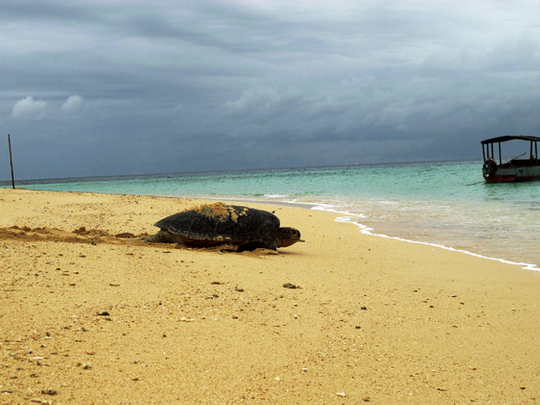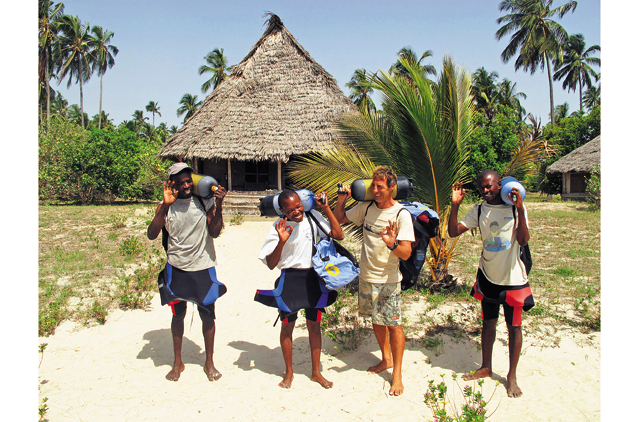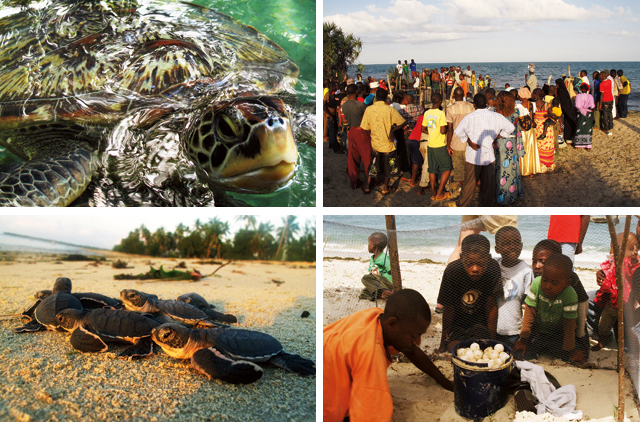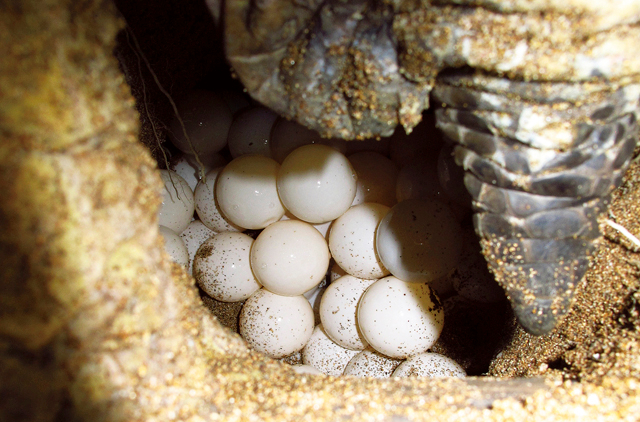
Huddling on the beach, the small crowd quietened, waiting to watch one of nature’s miracles. The sand began to shift. Slowly at first and then faster and faster until the first baby turtle beak poked out into the evening air.
After a pause, the tiny creature erupted from its nest and, wildly flapping its miniature fins, made a desperate dash across the sand to disappear into the sanctuary of the sea foam.
This was the first of over 90 newly hatched green turtles to tumble out on to the beach that evening, streaking down the sand one after the other to begin their perilous journey to adulthood.
It was a truly village affair for the residents of Tanzania’s Ushongo Beach because the turtles, which were once caught for food, are now a source of pride, turning fishermen into friends and conservation into a way of life.
The story of these little turtles began six decades ago on a remote island eight kilometres out to sea, close to the junction of the Pemba and Zanzibar Channels. Maziwe Island is one of the oldest marine reserves in Tanzania, and in the past was home to a complex and diverse ecosystem both above and below the waves.
Once covered in trees and lush vegetation, Maziwe was a perfect breeding ground for green turtles – so named because they’re vegetarian and feed off the local seagrass beds.
Over the years, as the trees were cut down for firewood, erosion set in and stripped the island bare until all that now remains is a barren and burning sandspit. This kind of habitat change has brought green turtles to the brink of extinction in Tanzania as hundreds of nests are being submerged by the tides and washed away.
In a cruel twist of fate, the turtles that hatched on Maziwe are genetically programmed to return and lay their own eggs there from when they are around 25 years old, every year until they die.
Painstaking solution
It was this predicament that encouraged resident divers Wim van den Bergh and Kerstin Erler to do something extraordinary. As diving instructors and owners of Kasa Divers, the ocean is their life and they soon realised that the answer was simply to move the nests – a delicate process that takes hours – and five years ago the first eggs were relocated from Maziwe to the sand outside their dive shop on Ushongo beach.
For Kerstin, it is all about the future: “Maziwe has a very small turtle population left that is still nesting. It was absolutely essential to start the project and to relocate the eggs to safety whilst this population is still laying. It gives us the chance to establish a new population that will lay their eggs in safety starting in about 25 years’ time.”
This is not a government-sponsored project, or a registered charity, but a truly local concern. Although Wim and Kerstin began the work, they are supported tirelessly by local turtle conservation team, Rajabu, Mungia, Moamed and Hatibu. The whole of Ushongo Village is involved and regular meetings take place to make decisions on the project. The Friends of Maziwe is a powerful force for good in a region that plays a critical role in the ocean’s ecosystem. The turtle team are now experts at the daily routine of relocating the nests.
Each day, the gentle hum of an outboard engine breaks the dawn silence as a patrol sets off for the hour-long journey to Maziwe. If a female green turtle has come ashore in the night, she will have laid her eggs in her nest and slipped back into the sea before sunrise. The wardens are practised at tracking them, but the skilled work really begins when a nest is located, and Wim and the turtle team have learnt from experience, it can’t be rushed.
“The eggs can be laid an arm’s length down in the sand,” he says. “We have to bring them up slowly and carefully one at a time. They have to be placed in the bucket exactly the same way up as in the nest; they cannot be twisted or turned in any way because if we break the delicate membranes inside, the egg won’t hatch. Relocating a nest can take hours as each contains around 100-150 eggs.”
The precious bucket is then stowed securely on the boat and driven back 15 nautical miles to the dive centre where the eggs are counted, dated and reburied. The site is protected and patrolled for the next 50 or so days until they’re ready to hatch.
This is unpaid work; made possible by donations from divers and tourists and money from the project’s Adopt A Turtle scheme. This fund-raising pays for petrol but little else, Wim says. “It’s easier this way, we don’t have any overheads or anybody else to answer to, not like the big charities.”
Spurred by success
Despite its lack of funding and low profile, the hatchings at this project have achieved a success rate of 80 per cent. Since 2010 the team has moved over 150 nests and more than 15,000 baby turtles from these have hatched successfully. In the process they have established a new breeding ground for their hatchlings to return to when they have matured and are ready to begin the cycle again.
It’s a long haul, but Kerstin can’t hide her delight at the prospects ahead. “In the next 25 years the first of our turtles will return to this beach, that is when we know our work has made a difference.” The oceans are dangerous and a newly hatched turtle in the wild faces odds of just 1000:1 of surviving to maturity. A female lays 1,500 eggs in a lifetime, which with these odds, means she may only be able to replace herself and not add to the critically endangered population, which is still in decline.
These magnificent creatures are at the mercy of fishermen, frequently becoming entangled in nets, injured by boats and sadly, hunted for their meat, which is considered a delicacy in local cultures. It is sobering to realise that for every turtle killed, a thousand little ones must hatch if there is any hope of the species surviving. Kerstin’s aim is to cut the odds of them being killed.
“In the wild about 20 per cent of a nest will be lost on the way to the water, and more eaten in their first few days. At the hatchings, we wait until dusk when it’s cool, and then sweep the beach to get rid of crabs and other predators so the little turtles get as safe a path as possible into the sea. This could mean that out of 150 eggs, two or three may mature and not just one – it makes a big difference to the numbers.”
So, the quiet work of projects like the one on Ushongo Beach is currently the best hope there is for these majestic sea creatures around the shores of Tanzania. Kerstin, Wim and the turtle wardens will continue their daily trips to Maziwe and keep vigil until their babies return and a new cycle is established on safer sands.
Back on the beach on that first evening, it seemed entirely right that just as the tiny turtles made their way to the sea, a sudden breeze stirred in the palm trees. A whisper to send them on their way and, with luck, to call them back again.















